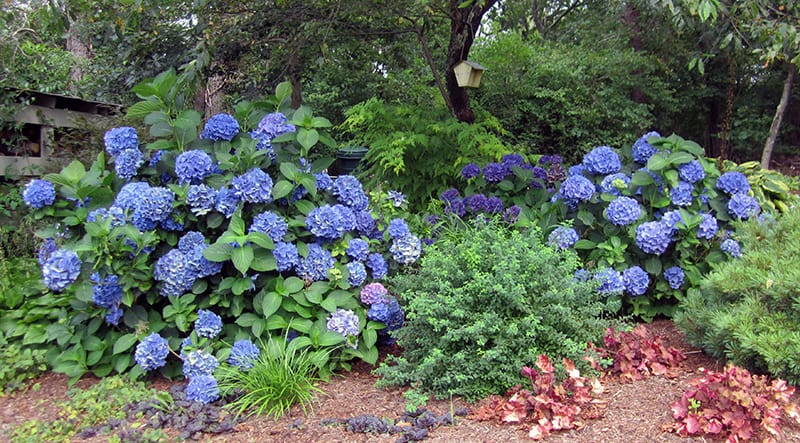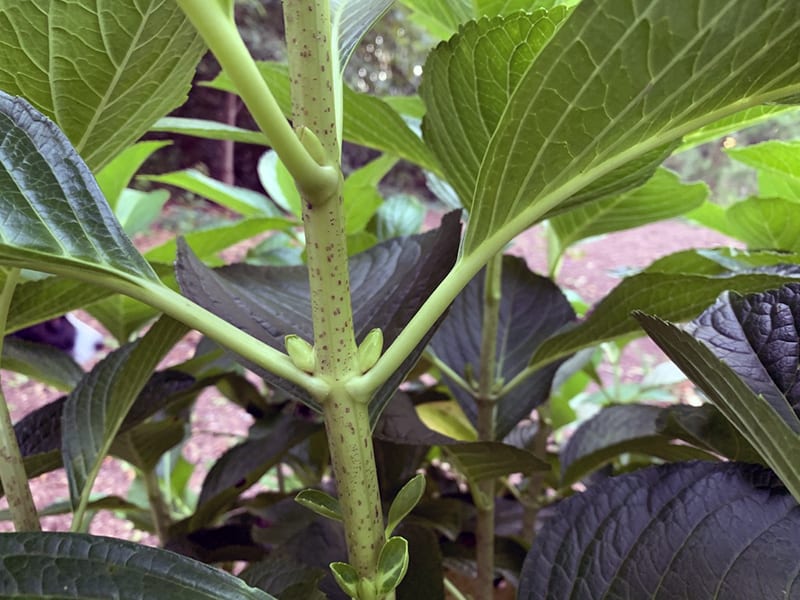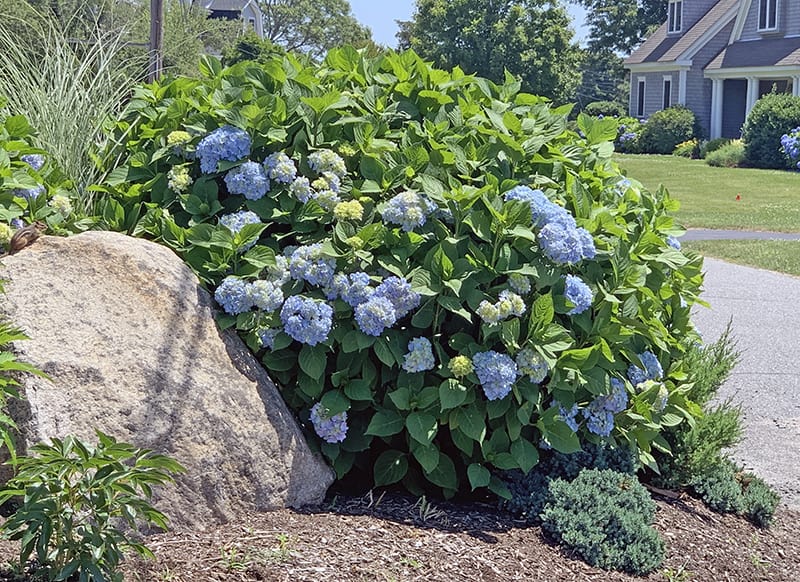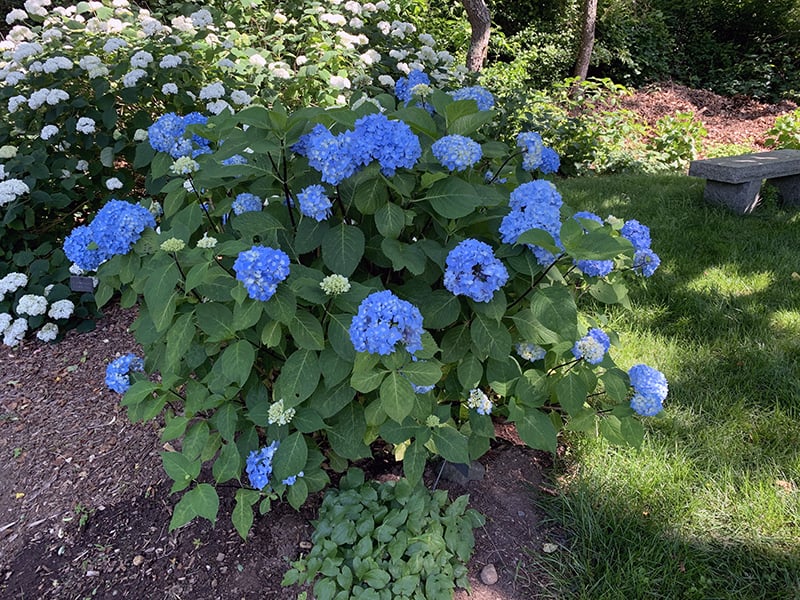I was doing a Zoom presentation for a group last week, and one of the questions from an attendee was about his blue hydrangea. “It never flowers,” he said, “no matter what we do.” Since this group was from all over the country, I asked him where he lived. It turned out that he was in Illinois, so I knew why his blue hydrangea wasn’t flowering: it gets too cold in the winter, and the flower buds get zapped. This question reminded me that people all over the world wonder how they can grow blue hydrangeas. How to get them to flower, keep them blue and not pink, or prevent the flowers from browning quickly in the summertime. So here are the basics of how to grow these lovely shrubs.

I live on Cape Cod where the blue hydrangea is our signature plant. These two on the right and left are one of my favorite varieties: Mathilda Gutges. The darker blue behind is an unnamed variety that I got as an Easter plant in the supermarket.
- The blue mophead hydrangeas are all varieties of Hydrangea macrophylla. This is important because of how and when their flower buds are produced. The photo of the shrubs above was taken in late August, and although the flowers are what capture our attention, know that the buds for next year’s flowers are already on these plants. Knowing that the flowers for next summer are formed in the late summer the year before is the key to knowing why your plant does or does not bloom. Flowering depends on those buds making it through the winter, and not getting cut down by pruning at any time of the year.

See the fat, green buds that are in the space between the main stem and where the leaf attaches? That place is called the leaf node, and the buds for next year’s flowers are formed there.
- If the winter temperatures fall much below 15° f. those buds are likely to be killed. Some varieties are more prone to this bud death than others. Some Hydrangea macrophylla varieties have buds that swell and almost start to break dormancy in a warm fall, and these are more likely to get killed by winter temperatures. If both day and night-time temperatures fall into the single digits, especially for days at a time, the buds are more likely to die. And if your winter temperatures fall below zero degrees Fahrenheit those buds will be zapped for sure. And no, protection by wrapping or mulching does not work. Sorry. If you live in a part of the country where your winter temperatures are so cold, see below for a way you can still grow these plants.
Another reason your hydrangea might not flower is if someone cuts the canes back in the fall or spring. Since the flower buds for next year are formed the summer before, you can understand that “neatening the plant up” in the fall or spring will remove those flower buds. The general rule of thumb for these plants is to wait until late May and at that point remove any canes that do not have green buds or leaves on them. If all the canes have died to the ground, you can remove them but that plant will not flower in the coming summer. If the buds don’t freeze in the winter, but the canes are “neatened up” in the fall, you’ll find a dome of green on the top of the plants and all the flowers will be on the bottom. See the photo below:

This is how a mophead hydrangea looks when someone has “cleaned it up” by cutting the canes back in the fall or early spring. The plant replaces its height in a few short months, but that new growth has no flowers. So you end up with green tops on the plant with flowers below. This shrub would have been covered from top to bottom with flowers had it not been pruned.
-
- To keep hydrangea flowers blue the plants must be growing in acidic soil. It’s the aluminum in the soil that turns the flowers blue, but that can only be absorbed in acidic conditions. In some areas, like on Cape Cod, the soil is naturally acidic and if you do nothing your flowers will be blue. But in other parts of the country the soil is alkaline, and so sulfur should be applied around the plants in order to turn the flowers from pink to blue. You should apply sulfur according to directions in spring and fall, and be sure that it’s spread well beyond the drip line around the plants.
- Blue hydrangea flowers last longest when they are protected from wilting in hot weather or in full sun. Even when well watered the blooms can wilt when temperatures are above 80 degrees or when the plants are growing where the noontime and afternoon sun hits them. So for the longest lasting flowers, grow these shrubs where they are in sun in the early morning but in the shade from ten AM on. If you live in a region where the summer temperatures are routinely above 90°, this is not the plant for you.

Enchantress hydrangeas flower well in dappled sunlight or where there is morning sun and afternoon shade.
- If your winter temperatures prevent your plants from flowering, grow these in pots! There are many shorter varieties such as Blue Jangles that do well in containers. Pull them into an unheated garage, bulkhead or cold basement once they have lost their leaves in the fall but before the temperatures have fallen below 30° for any length of time. Water them if the soil is dry, and don’t worry if these plants start to break dormancy in the early spring. Pull the pots outside once all danger of frost is past, fertilize, and place the pots in a shady location.

The hydrangeas in these pots have been growing in containers for five years. They get an organic fertilizer every spring and a top-dressing of compost. The plant on the left is Blue Jangles, the one in the back on the right is Bloomstruck, and the lacecap in the right foreground is Let’s Dance Diva. Look for shorter varieties of Hydrangea macrophylla for containers.
- So to wrap up: for the best blue hydrangea blooms, grow where the winter temperatures stay above 15° F, never cut them back unless the canes are empty and dead in late May, grow them in acid soil and be sure the flowers are protected from hot, mid-day sun.

I received these in a pot for Mother’s Day they were such a beautiful color of a purple Lu now there turned dull. Can I keep them in a pot and will they grow? Should I transplant in a big pot I live in swansea ma
These do not make good houseplants. The varieties that are sold for gift plants are sometimes bud-hardy enough to bloom next year, but sometimes not. If the gift wasn’t labeled with a variety name that you can look up, it’s impossible to tell if yours will flower if planted outside or not. The flowers naturally fade in about three months, which Hydrangea people call their “antique phase.” Plant it outside where it will get some morning sun but afternoon shade, and see what happens next summer.
Here’s the truth about these plants: First of all, it’s hard to keep a gift Hydrangea in good shape because they come from the grower where they have been raised on flooding tables that keep them constantly moist but not so wet that they rot. This is pretty impossible to duplicate on a home level, so they often dry up. Secondly, these Hydrangeas do best outdoors in climates where it is never too hot during the day…in temperatures over 85 they wilt, even if the soil is moist, since the big leaves and flowers transpire water through their pores faster than the roots and stems can replace it. After wilting several times, the flowers brown. And finally, even if you manage to water it enough to keep it from browning, the flowers are only blue and fresh for two months at most. After that they turn into what Hydrangea geeks call “their antique phase”, when the flowers turn sea green, lavender and a bit gray. So it’s not you. These plants were never intended to grow well in Florida.
I received a beautiful Blue Sunset plant for Mother’s Day. It looks terrible. I either had dry leaves or wilted leaves and flowers. I can’t get it right and don’t know what to do with it. I live in Florida.
I have a early blue hydrangea growing in pot on deck. Flowers died, but still growing green leaves by the tons. Will it grow more flowers and can I keep it alive if in my house in winter. I live in Northern Minnesota.
Elda,
Some hydrangeas flower again on new growth – these are called remontant varieties. I have no idea if you have one of those or not. These shrubs do not make good houseplants, however. You can put them in an unheated garage where the temperatures won’t go below freezing, and this is quite successful. See this post: https://gardenlady.com/growing-hydrangeas-in-containers/
I live in western Mass. I love blue hydrangeas and bought three endless summer, however it’s now the end of June and the places I were going to place them are not ready. Should I pot these until the fall or keep them in their containers they came with? Or should I plant them in July?
Heather – Plant them in July…as long as they will indeed be in the ground by July 29th. If not, put them in larger pots now, at least 3″ bigger on all sides than the pots they are growing in now. Then once you have the place ready, put them in the ground. The bottom line is the sooner they are where they will be growing into the future, the better established their roots will be before winter. Plant them in as sheltered a place as you have, being sure that this area is shaded from 11 AM until 3 PM.